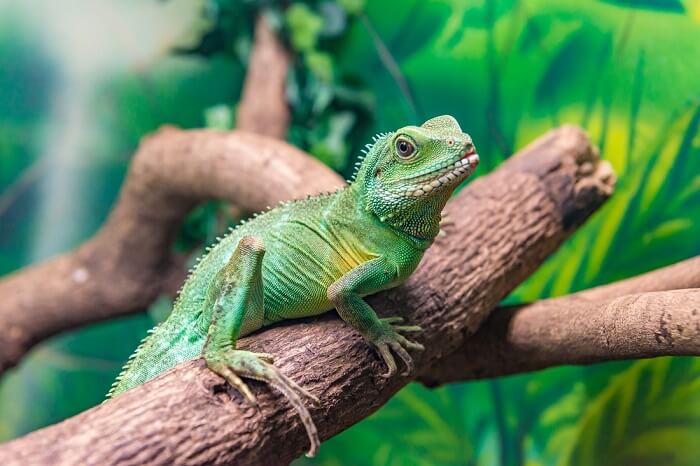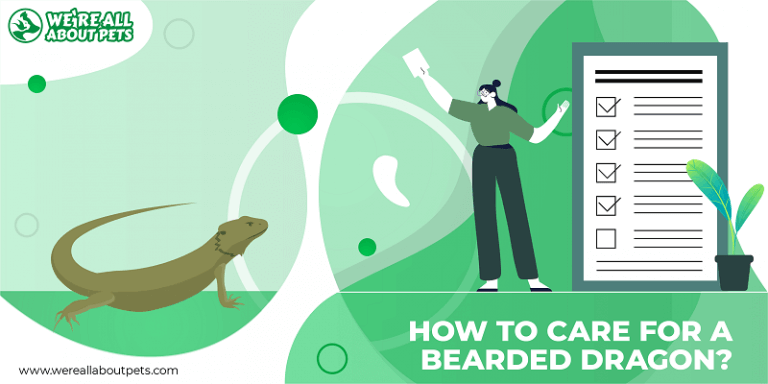12 Different Types Of Leopard Geckos That Make Great Pets
This page contains affiliate links. We may earn money or products from the companies mentioned in this post through our independently chosen links, which earn us a commission. Learn More
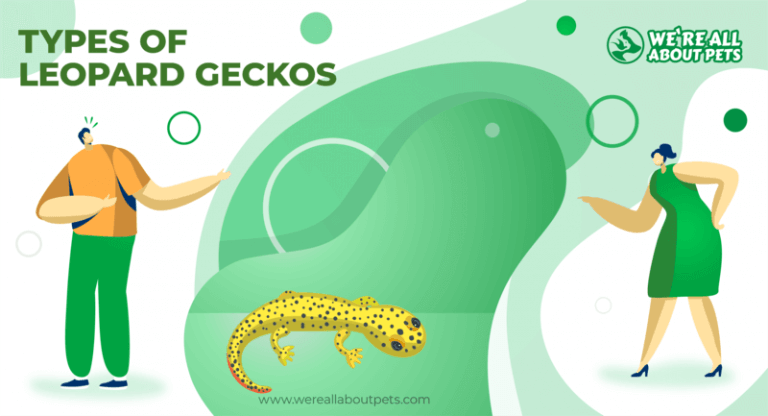
Reptiles make interesting pets, but some of them can be quite challenging to keep. Leopard geckos are a great beginner reptile because they are fairly low maintenance and easy to tame. Like any pet, however, they have certain requirements for care that need to be met.
Before you even get to the point of researching the basics about how to care for a leopard gecko, however, you may be wondering what makes these pets so popular.
Leopard geckos are named for their spotted coloration, but that’s only one of the many things that makes them so popular. They are fairly small and docile lizards as well. What you really want to know, however, is how many types there are. Keep reading to find out.
Quick Navigation
12 Adorable Types Of Leopard Geckos You Should Know
Also known as the common leopard gecko, the leopard gecko is a ground-dwelling lizard native to the grassland and desert regions of Pakistan, Afghanistan, Iran, and north-west India. Leopard geckos are insectivores, not omnivores like many reptiles, and they can’t digest plant matter.
These lizards have been bred so extensively in captivity that they are often referred to as the first domesticated species of lizard. Though there is only one species of leopard gecko (Eublepharis macularius), there are a number of different color morphs.
Here’s a quick overview of some of the most popular leopard gecko types:
1. Albino Leopard Gecko
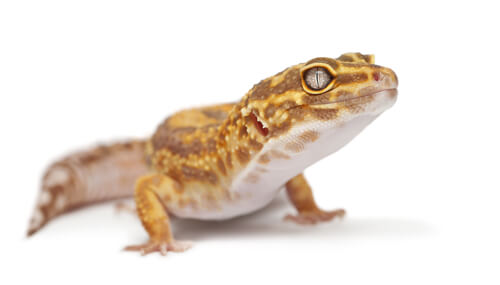
- Origin: Asia
- Price: $30 to $300
- Size: 8 to 11 inches
- Color: Various
The albinism exhibited in leopard geckos is a little different than in other animals. In most cases, albinism is caused by a lack of the enzyme tyrosinase that prevents the animal’s skin from producing melanin or pigment. In colorful leopard geckos, the skin produces very little melanin anyway, so albino morphs usually have some kind of light coloration and are technically speaking amelanistic rather than albino.
2. Aberrrant Leopard Gecko
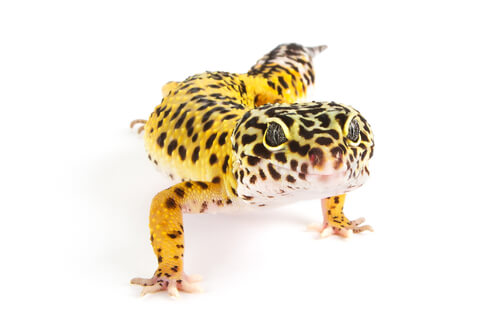
- Origin: Asia
- Price: $50 to $200
- Size: 8 to 11 inches
- Color: Various
The aberrant leopard gecko is simply a morph with a broken pattern. The normal or wild leopard gecko morph typically has spots all over the body but may have bands of color as well. If there is a break in the bands where an oval appears in place of a line, it’s an aberrant morph. You can combine an aberrant leopard gecko with other morphs since the name is a reference to the pattern.
3. Baldy Leopard Gecko
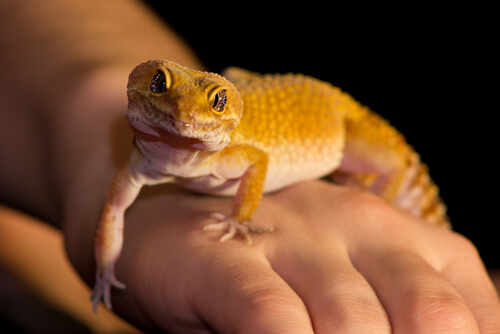
- Origin: Asia
- Price: $50 to $100
- Size: 8 to 11 inches
- Color: Various
As you might guess from the name, the baldy morph is one that has no spotting on its head. The term baldy refers specifically to the lack of spots on the head, so this morph comes in a variety of different colors. The price increase depending how much color they have.
4. Carrot Tail Leopard Gecko
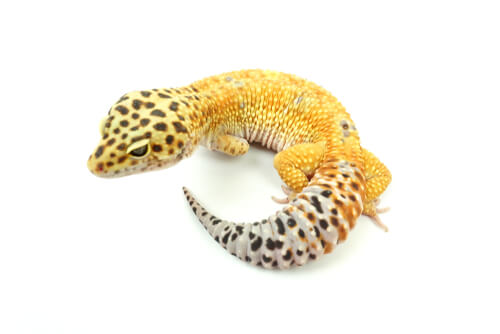
- Origin: Asia
- Price: $125 to $200
- Size: 8 to 11 inches
- Color: Orange
This particular leopard gecko morph is named for the orange coloration on its tail. Specifically, carrot tail leopard geckos have at least 15% of the tail covered in orange. Like many morphs, the carrot tail specification can be used in combination with other names. Most carrot tail leopard geckos are RAPTORs, patternless, tangerine, or albino morphs.
5. High Yellow Leopard Gecko
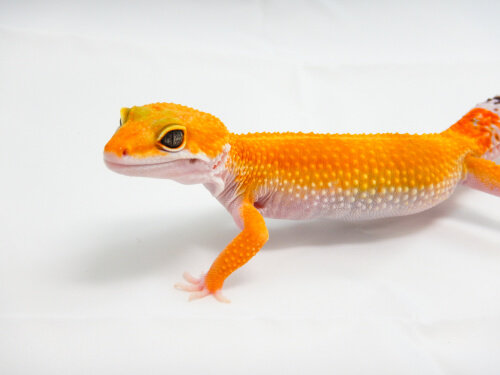
- Origin: Asia
- Price: $75 to $125
- Size: 8 to 11 inches
- Color: Yellow
Before leopard geckos were selectively bred to create over 100 different color morphs, the only option other than the wild morph was high yellow. High yellow leopard geckos have more yellow coloration, as you can imagine, but also has fewer spots than the normal morph. This morph can also be combined with others like the Jungle morph to create a completely unique appearance.
6. Jungle Leopard Gecko
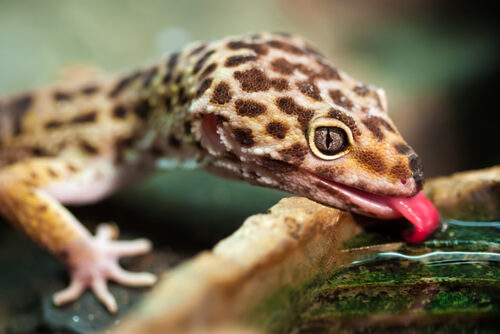
- Origin: Asia
- Price: $40 to $125
- Size: 8 to 11 inches
- Color: Various
This leopard gecko morph is very similar to the aberrant, except the broken pattern appears both on the body and the tail. Like many morphs, the jungle morph can be a combination morph exhibiting several different distinct patterns or colors.
7. Lavender Leopard Gecko
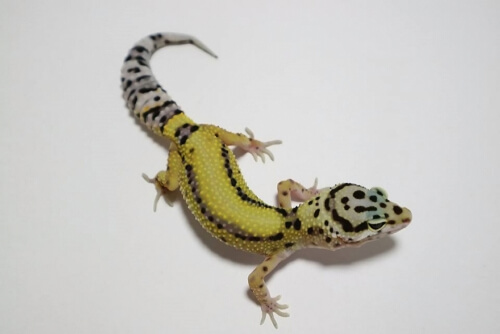
- Origin: Asia
- Price: $75 to $250
- Size: 8 to 11 inches
- Color: Lavender
Aptly named, the lavender morph is a leopard gecko with a light violet or lavender coloration. Breeding for this morph can be difficult because many leopard geckos lose their lavender coloration as they mature.
8. Melanistic Leopard Gecko
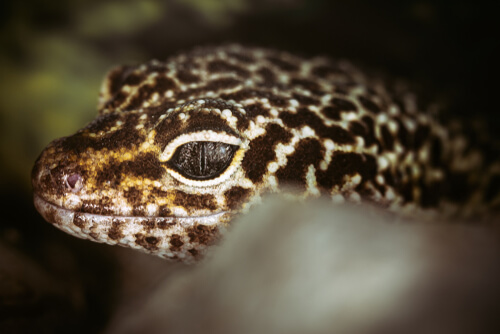
- Origin: Asia
- Price: $150 to $300
- Size: 8 to 11 inches
- Color: Black
Also known as the black night leopard gecko, the melanistic leopard gecko is almost entirely black in color. The term melanistic refers to an intense coloration much stronger than normal morphs.
9. Raptor Leopard Gecko
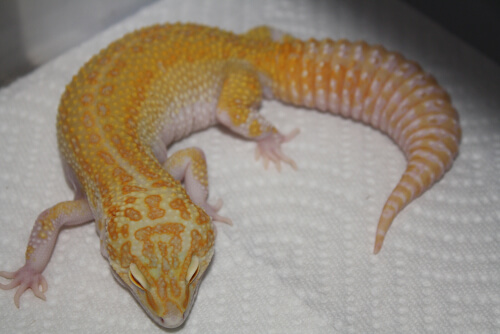
- Origin: Asia
- Price: $80 to $150
- Size: 8 to 11 inches
- Color: Orange
The name for this morph is actually an acronym – Red-Eyed Patternless Tremper Orange. The RAPTOR leopard gecko is an albino morph with red eyes and an orange body. These geckos have no black spots and are generally considered a combination morph.
10. Reverse Stripe Leopard Gecko
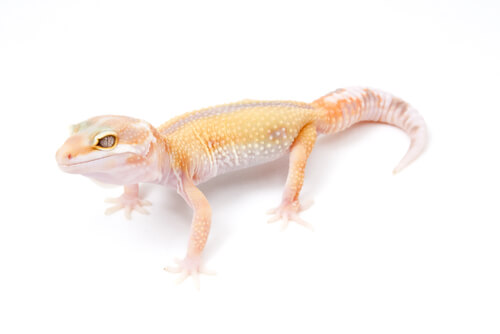
- Origin: Asia
- Price: $100 to $200
- Size: 8 to 11 inches
- Color: Various
Leopard geckos usually have a pattern combining various bands, stripes, and spots that differ according to the morph. A reverse stripe leopard gecko has a stripe running all the way down its back from neck to tail. The color of the stripe may vary, and the term reverse stripe is usually used in conjunction with other morph names, making this a combination morph.
11. Super Giant Leopard Gecko
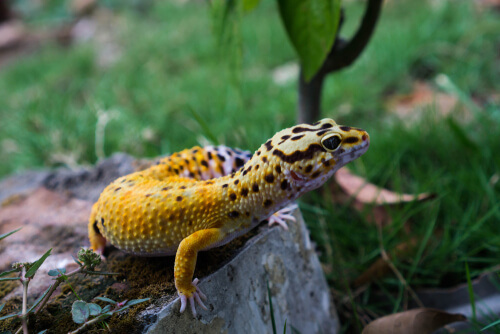
- Origin: Asia
- Price: $200 to $700
- Size: 12 inches
- Color: Various
Most leopard gecko morph names refer to the color or pattern, but this particular morph refers to the size. Super giant leopard geckos are the largest type, growing nearly 12 inches in length. Giant leopard geckos are bigger than the normal morph, but super giants are even bigger.
12. Tangerine Leopard Gecko
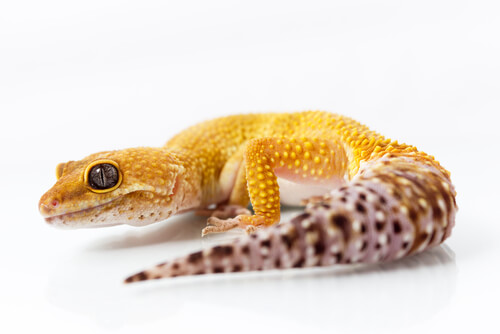
- Origin: Asia
- Price: $80 to $400
- Size: 8 to 11 inches
- Color: Orange
Just as the lavender leopard gecko is named for its lavender coloration, this morph is named for its orange coloration. Tangerine leopard geckos can be any shade of orange but the ones that fetch the highest prices are the ones with the most intense coloration.
The Benefits of Owning A Leopard Gecko
When you hear the phrase “companion pet” you probably picture something fluffy like a dog or a cat. Reptiles are not the typical companion pet, but they certainly can be! The leopard gecko is a great option for beginner reptile enthusiasts and for those looking for a reptile that will enjoy handling.
Another benefit is that once you set up your leopard gecko terrarium, the cost to keep your leopard gecko will be fairly low. You can even raise your own insects to reduce the cost of feeding.
Here are some of the benefits of leopard geckos as pets:
- The leopard gecko is generally a docile reptile and can be very easy to tame with regular handling on your part and positive reinforcement.
- In terms of habitat, leopard geckos can do quite well in a 15- or 20-gallon tank as long as it is outfitted properly and maintained at the right temperature and humidity.
- Leopard geckos are able to regrow their tails if they fall off. Self-amputation is defense mechanism for many lizards, so if an accident happens your gecko’s tail will grow back.
- The leopard gecko is a nocturnal animal which means it spends most of the day sleeping. This can be a good thing if you prefer quiet around the house during the day.
- Unlike many reptiles, leopard geckos do not require a lot of UV lighting to help them synthesize calcium. A small amount of UVA and UVB lighting is recommended, however.
- Leopard geckos are desert dwellers, so they don’t need their environment to be kept very humid- they only need about 30% to 40% humidity.
Though leopard geckos are generally very docile and easy to tame, you need to give your pet time to get used to his new surroundings after bringing him home. Give your pet a day or two in the new terrarium to get a feel for things but don’t feel like you have to avoid him completely.
Spending some time in the room with your gecko speaking and letting him get used to your smell is important. You can even place your hand in the terrarium without picking your gecko up.
What To Know Before Getting A Leopard Gecko?
One of the biggest benefits of leopard geckos as pets is that they are fairly easy to tame. The thing you need to remember, however, is that taming your gecko is an ongoing challenge and you need to interact with and handle your gecko regularly to keep him tame.
Here are some other important things to consider for leopard geckos:
- Make sure your leopard gecko terrarium has a tight-fitting lid. While leopard geckos don’t have sticky toes like some other species, they can still be sneaky.
- Provide your leopard gecko with places to hide in the terrarium. Remember, these are nocturnal reptiles so your pet will want somewhere to sleep during the day and a place to cool off.
- Leopard geckos are very long-lived. You should expect to care for your leopard gecko for up to 20 years, so know that it is a long-term commitment!
- Your gecko needs about 12 hours of visible light per day to maintain his natural cycle. Unlike some other reptiles, however, leopard geckos do not require UVB light.
- The leopard gecko requires a warm, humid environment but be sure to keep one side of the tank a little cooler than the other.
- Leopard geckos like to dig and burrow, so make sure your terrarium has a few inches of soft substrate your gecko can dig into to hide or rest.
- The leopard gecko is a tail rattler, like a rattlesnake. If you notice your gecko rattling the tip of its tail, it may be a sign of excitement or it could mean he’s in a bad mood or feeling frightened.
Leopard geckos make wonderful pets, but they aren’t the right choice for everyone. If you have your heart set on this lovely reptile, take what you’ve learned here to decide which type of is best for you.






